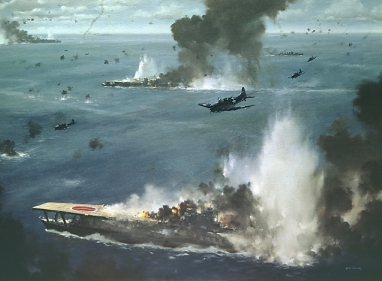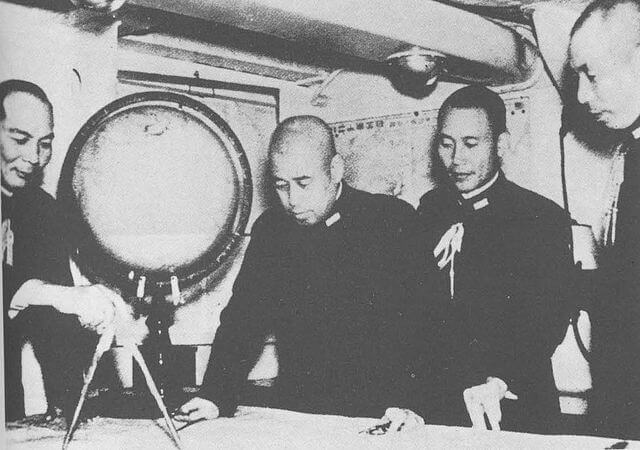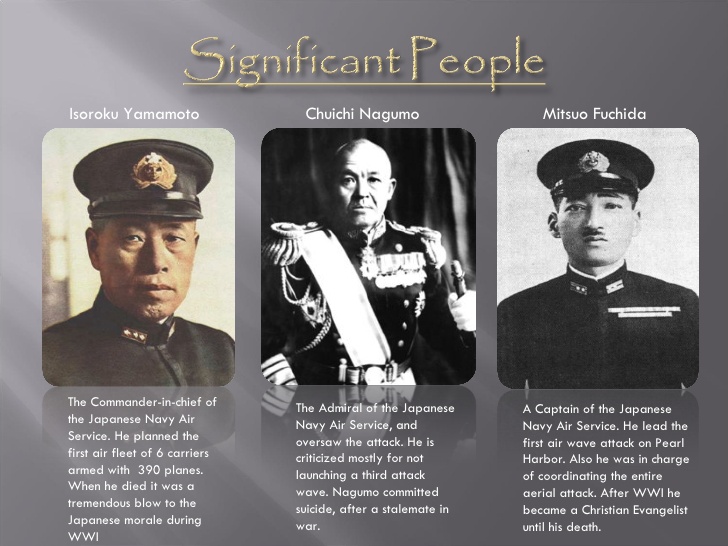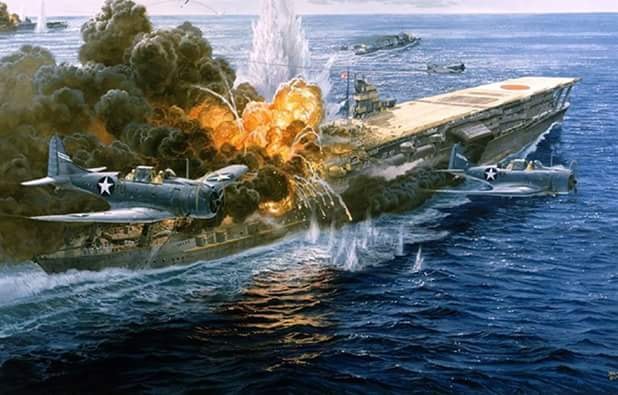Blown Slick Series #13 Part 6
Into the Shredder
The Battle of Coral Sea had provided the first hints that the Japanese high-water mark had been reached, but it was the Battle of Midway that put up the sign for all to see. Midway also marked the gateway to the attritional war that would be fought in the Solomons, a campaign that would irreparably ruin the Japanese Navy by destroying its elite naval aviation cadres and wrecking its surface forces beyond redemption. Midway didn’t produce these consequences by itself, but it created the circumstances whereby the Japanese Navy would be fed into the shredder. *
The Japanese had the overall numbers, they had the experience, they had the initiative, and for all practical purposes they decimated three torpedo squadrons and annihilated the Army Air Corps, Marine, and Navy attackers from the island. So why did they lose?
Initial U.S. analysis after the battle was as follows:
- Over confidence of Japanese forces – victory disease
- Admiral Yamamoto’s battle plan.
- his operational scheme featured an overly rigid timetable and
- plan designed around his perceptions of U.S. intentions rather than their capabilities,
- rigidity of Japanese planning – in that the Americans were expected to react in a scripted fashion
- Excessive reliance on the element of surprise in developing his plans followed by actual loss of the element of surprise – U.S. code breaking
- Counterproductive and finally fatal dispersal of forces over too great an area resulting in lack of superiority at the point of contact.
- Too few airplanes and too much ocean to cover.
“In summary, the plan that emerged was a crazy quilt of formations and objectives, none of which were mutually supporting. When one of the legs of the table was kicked out, the entire article promptly collapsed under the weight of its own foolishness.” *
In 1947 Rear Adm. Samuel Eliot Morison observed in the preface of volume one of his enormously influential “semiofficial” History of United States Naval Operations in World War II
“No history written shortly after the event it describes can pretend to be completely objective or even reasonably definitive. Facts that I know not will come to light; others that I discard will be brought out and incorporated in new patterns of interpretation.”
In that light, over time several more nuanced and systemic reasons for the loss have been put forward, with possibly the most telling stemming from the in depth analysis of Japanese documentation and perspective – most significantly as noted previously in the work of Tully and Parshall in *Shattered Sword. (Leading quotes)
There are many well researched and well written books on Midway. Given the nature of this series focus on carriers in battle rather than battles themselves, it would seem the remainder of Part 6 discussion would best be served by reflection on that analysis by Tully and Parshall. The intent is to isolate and highlight their specific take on why the Japanese lost. What follows includes extractions from Chapters 22 and 23 with some minor editorial modifications for format and clarity in context of Rememberedsky focus.
As part of their research they noted that important insights could be gleaned from the study Military Misfortunes: The Anatomy of Failure in War by Eliot Cohen and John Gooch, which lays out a useful framework for analyzing why militaries fail in battle. Using this framework, it became clear to them that it wasn’t just Yamamoto or Genda who failed at Midway; indeed in several important ways, the entire institution of the Japanese Navy was to blame as well.
First, Cohen and Gooch’s framework: they propose that all military failures fall into three basic categories:
- failure to learn from the past
- failure to anticipate what the future may bring
- failure to adapt to the immediate circumstances on the battlefield.
They further note that when one of these three basic failures occurs in isolation (known as a simple failure), the results, while unpleasant, can often also be overcome. Aggregate failures of two of the basic failure types, usually learning and anticipation, take place simultaneously, and these are more difficult to surmount. Finally, at the apex of failure stand those rare events when all three basic failures occur simultaneously-an event known as catastrophic failure. In such an occurrence, the result is usually a disaster of such scope that recovery is impossible. Sadly for the Japanese, Midway must join the ignominious ranks of this level of calamitous compound failure.
Tully and Parshall state:
“Taken as a whole, the inescapable conclusion that emerges from a careful examination of the battle is the fact that the Japanese defeat was not the result of some solitary, crucial breakdown in Japanese designs. It was not the result of Victory Disease, nor of a few crucial personal mistakes. Rather, what appears is a complex, comprehensive web of failures stretching across every level of the battle-strategic, operational, and tactical. Every aspect of the enterprise was tainted in some way.
The surface manifestations of these deeper failures may ultimately have been a host of mistakes committed by individuals. And some of those mistakes were clearly more important that others. But the vast majority of them were in some way symptomatic of larger failures within the Japanese military and within the Navy’s cultural fabric, its doctrine, and its preferred modes of combat. They were the end products of an organization that failed to learn correctly from its past, failed to plan correctly for its future, and then failed to adapt correctly to circumstances once those plans were shown to be flawed.
Intriguingly, the seeds of many of these errors had been planted some forty years before, through the initial teachings of the Japanese Naval Staff College, and from the flower of Japan’s greatest victory-the Battle of Tsushima. They had lain unnoticed all that time, growing unchecked, waiting for the right time, place, and individuals to give them expression. Instead of culling these warped seedlings, the Japanese Navy had fostered their growth in the 1930’s. The twin pressures of a violent nationalism, combined with the sure knowledge that they would be the underdog in any war with America, had conspired to skew Japan’s naval policies and doctrine still further during that time period. As a result, by the time the Pacific war began, and despite its undoubted tactical prowess, the Navy’s ability to mentally fight the war at a strategic and operational level was already fatally damaged. It was at Midway that the breadth of these shortcomings finally revealed themselves, with catastrophic results for both the Imperial Navy and the Japanese nation. Of course, in the larger context of the war, the Battle of Midway was just one of the first of a much greater harvest of bitter fruit that would fall from the poisoned tree of Japanese militarism.
The military defeats that began with the Battle of Midway stem from the harsh reality that, far from being the truly modern, progressive institution that it fondly imagined itself to be, the Imperial Navy was in fact possessed of the most parochial of outlooks. Instead of the quick, limited war Japan’s military leadership envisioned, the Pacific war soon revealed itself to be all encompassing and all consuming. In a shockingly short time, America had begun waging war against Japan across every strategic dimension available to a great industrial power-military, political, economic, and scientific. Japan was assaulted on the ground, through the air, and on and under the sea. Ultimately, it was beaten decisively in every one of these arenas.
In this sense, Midway was merely symptomatic of the imperial military’s larger failings. Most obvious was their fatally misguided decision to launch a war of aggression against the most powerful nation on earth. Having done so, moreover, they found themselves engaged in a conflict whose scope and complexity forced its participants to evolve at a frenetic pace. As it developed, for the Japanese this was a particularly daunting challenge. Despite the amazing speed with which they had modernized their fighting forces after 1848, they were still bound by thought patterns linked to an earlier military and cultural era, as well as the warped legacy of Tsushima. In the final analysis, it is no exaggeration to say that the conflict the Japanese military instigated in 1941 was not only beyond its resources, but also beyond its understanding.”
As stated previously, there are many excellent books covering all aspects of the Battle of Midway spread over the 76 years since the battle. Just noting six of those that were accessed for this post , the dates of publication are 1951/1955, 1967, 1983, 2005, 2006, and the latest, the anthology from the Naval Institute in 2013.
The thrust of this piece has been to separate out analysis of how the most experienced carrier based navy, the IJN, operated in the second major clash of carriers. Part #7, What did Midway really mean?” will address Midway, IJN operations, and overall carrier operations for potential learning for future carrier operations, before turning to the two carrier battles at Guadalcanal.
For a more detailed look at Shattered Sword’s analysis, please continue to read extracts from Tully and Parshall in outline form below.
From Chapter 22 and 23
1) Failure to learn indicates that a military has been either unable or unwilling to adequately address the lessons of the past.
a. Imperial Navy’s failure to draw correct conclusions from the past stemmed in large part from its crowning naval triumph at Tsushima in 1905.
1. Tsushima seemed to confirm the notion that naval power could be used to shape and control conflicts so that they remained localized and were fought for limited objectives.
2. Tsushima (falsely) taught the lesson that victory at sea devolved solely from winning climactic fleet engagements. This lesson seemed inescapable, since Tsushima was one of the most decisive naval battles in history, resulting in the utter annihilation of the Russian fleet.
3. Tsushima implanted in the Imperial Navy the unfailing belief in the primacy of offensive factors, as compared to defensive considerations. Tsushima cemented the notion that big guns were the final arbiter of any naval encounter, a belief further reinforced by the clash of heavily armed battle lines at Jutland.
b. These three lessons were later fused unhealthily with Japan’s growing fixation after the First World War on the possibility of war with the United States. The Japanese understood that any such conflict would pit them against a foe whose numerical superiority was ultimately ensured by overwhelming industrial might. Seeing no way to fight numbers with numbers, the Imperial Navy fell back on the unswerving belief that quality-if wielded with superior skill and Japanese fighting spirit (Yamato damashia)-must be able to defeat quantity.
1. As a result, the other traditional roles that great navies throughout history have embraced-protecting one’s commerce, destroying the commerce of the enemy, and conducting amphibious landings-were strictly subjugated to the Imperial Navy’s overriding need to augment the fleet’s raw offensive strength. Speed, range, and firepower were everything.
2. The problem was that none of these dictums was appropriate in the context of a global war in the Pacific, particularly a protracted one.
3. As for the cherished notion of creating a single decisive battle that would decide the course of the war, the Imperial Navy searched in vain throughout the conflict for such an engagement-first at Midway, and then elsewhere. The Japanese completely failed to understand that a power like the United States could never be brought to ruin-or even to the bargaining table-as the result of a single engagement, no matter how successful it was. The industrialized, massively mobilized nature of World War ii ensured that protracted warfare was practically inevitable. In such a setting, nations could be defeated only after the application of levels of cumulative force and destruction that beggared the imagination.
c. The third lesson from Tsushima manifested itself in the Imperial Navy’s continuing overemphasis on offensive factors. At the strategic level this meant that its naval force structure, while formidable in frontline strength, did not possess the characteristics needed for the protracted war it had unwittingly purchased for itself. And operationally, it meant that Japan came to Midway armed with a doctrinal outlook rigidly inclined toward the offensive.
d. the most important learning failure of the Imperial Navy concerned lessons not from prior wars, but rather from the first five months of the Pacific war itself. At the top of this list must stand the Navy’s inability to correctly perceive the underlying reasons for its success up until April 1942.
1. The only way for the Japanese to avoid being outnumbered and ambushed by a suddenly appearing enemy carrier task force that “wasn’t supposed to be there” was to bring the entirety of their own carrier force to every major operation. There really was no middle ground in terms of force allocation. Quantity had arguably been the critical factor in Japan’s seminal victories to date.
2. Given that fact, bringing the entire carrier force to an operation such as Midway was absolutely imperative. An astute naval leadership would have noticed this correlation, but the Imperial Navy did not.
3. Coral Sea and Midway make it clear that the Japanese Navy was going after too many objectives at once. It was dispersing its carrier assets, thereby casting aside its proven formula for victory In the process, it was unnecessarily elevating the Navy’s risk by placing irreplaceable combat assets in situations where its weaker opponent could temporarily concentrate superior numbers against them.
4. Had Yamamoto supplied his subordinate with true superiority of naval airpower at the point of contact, it could have widened Nagumo’s tactical options immensely
5. Midway hints at the start of a “learning gap” appearing between the two navies. This was a phenomenon that would become increasingly evident as the war progressed-the the U.S. Navy as an organization often (although not always) had a superior capacity for absorbing battle lessons and translating them into doctrinal and technical modifications that would aid it in future battles.
e. The overall conclusion is inescapable-the Japanese Navy had a learning problem.
1. The cherished precepts that it had carried down from Tsushima-the value of geographically limited wars, the primacy of offensive over defensive factors, and the supremacy of big-gun navies-were largely inapplicable to World War.
2. Furthermore, at its highest levels of command, the Navy had also failed to grasp the lessons of the war they had launched. Not the least important of these principles was the overriding importance in carrier warfare of numerical superiority, despite having emphatically driven that very point home for all the world to see at Pearl Harbor.
2) Failures of anticipation. As Cohen and Gooch point out, “The essence of a failure to anticipate is not mere ignorance of the future, for that is inherently unknowable. It is, rather, the failure to take reasonable precautions against a known hazard.” Along with its failures in learning, it is clear that the Imperial Navy failed to anticipate as it went into the battle of Midway.
a. At the level of operational planning, Genda was clearly guilty of failing to foresee that a larger number of scouting aircraft would be required to implement a thorough search. “Carrier attack planes could be used as scouts during transits to the battlefield. But once battle was joined, scouting with attack aircraft was to be avoided. If there weren’t enough floatplanes to do the job, it just didn’t get done.”
b. Nagumo’s failure-on the basis of the intelligence he had in hand before the battle-to anticipate that the American carriers might be present off of Midway. It is clear that Nagumo probably ought to have been suspicious of the level of American activity in the area, if nothing else. But he chose not to act on this intelligence. These tendencies were further reinforced by the military culture prevailing in the Imperial Navy, which valued conformity and obedience over creativity or personal initiative.
c. Yamamoto was clearly guilty of the sin of planning operations around perceived enemy intentions, rather than on the basis of the enemy’s likely capabilities.
d. The corollary failure that flowed from this assumption was Yamamoto’s decision to disperse his forces in the face of the enemy. By subdividing his superior mass into a welter of smaller formations that were not mutually supportive, the overall battle plan was unnecessarily weakened.
e. note that throughout the war, even as their strength weakened relative to the Americans, the Japanese never lost their fondness for complex dispersed operations.
f. It is clear in this regard that Japanese naval strategy was influenced from its very inception by Oriental philosophies on the conduct of war, which emphasized the value of deception and indirect approaches. Akiyama Saneyuki, the most brilliant thinker at the Imperial Navy’s Staff College at the turn of the twentieth century, drew heavily not only on contemporary Western naval practices, but also on ancient Oriental military masters such as Sun Tzu as he began hammering out Japanese naval strategic thought at that time. Akiyama’s principles, in particular his love of indirect approaches so as to conceal the true objective of an operation, were seen by the Japanese as laying the strategic foundation for the victory at Tsushima.
g. Unfortunately, at Midway the Japanese encountered a strategic problem where subtlety was a dangerous luxury. If ever a situation called for using brute force, this was it. But Yamamoto, shaped by his institutional training, adopted an elegant strategic approach that suited his service’s martial sensibilities, and it is likely that any other graduate of the Imperial Naval Staff College would have done likewise. In a nutshell, Japanese naval strategy was warped and was likely to produce unworkable solutions no matter who was in charge of the planning. In this sense, Chihaya’s complaint that the Japanese Navy had as “good as planned for” its defeat at Midway is true-but the reasons for that defeat reached back well before six months of overweening pride brought them into focus.
h. In sum, the Japanese Navy was clearly guilty of several crucial errors of anticipation. Genda’s anemic reconnaissance scheme, Yamamoto’s obtuse battle plan, even Kaga’s unlikely resurrection at the hand of Ugaki during the May war games-all were indicative of a Navy that had failed miserably to foresee what the future might bring. Instead, they habitually assumed that a “best case” rather than a “worst case” scenario would unfold in their favor-a bad idea in military planning. Thus, the Japanese came to Midway with a flawed doctrine, having drawn the wrong conclusions from the past, and having failed to absorb the most critical lesson from the current conflict (failure one). Moreover, their battle plan was similarly flawed and did not consider contingencies such as the American fleet being present off of Midway (failure two).
3) Failures to adapt.Despite these glaring problems, Nagumo still might have won the battle, or at least have made the outcome more even, if the Japanese had been able to adapt to the challenge of their changed circumstances.
a. By far the most important reason for these adaptive failures was an unhealthy rigidity on the part of the Japanese regarding the sanctity of battle plans. Indeed, this is a common theme for the imperial military that can be seen not only at Midway, but throughout the Pacific war as well.
b. it is clear that the Japanese held their plans in such high regard that, once in place, they were loath to alter them. This manifested itself in Yamamoto’s failure to adapt to the setback at Coral Sea. By not allowing Operation Ml’s timetable to slip, he lost the chance to include either member of CarDiv 5 in the starting lineup, and thus condemned Nagumo to fight on even terms at Midway, rather than from a position of strength. By
c. At an operational level, plan inertia manifested itself in a stubborn unwillingness to adapt immediately before and during battle. Karl von Clausewitz’s famous maxim that “No battle plan survives first contact with the enemy,” probably never met with a less enthusiastic audience than the Imperial Navy.
d. it is clear from many of the failures of learning and adaptation just discussed that the Japanese entered the Battle of Midway wearing doctrinal handcuffs, the effect of which was to retard still further their ability to innovate. Whereas American doctrine is generally presented to a commander as a codification of guidelines concerning the effective conduct of combat, the very nature of the Japanese military culture made its own doctrine far more rigid with regards to interpretation. This manifested itself in Nagumo and Genda’s disinclination to augment their tactical scouting assets with carrier strike assets, even in the face of accumulating evidence that the Americans were more alert than they ought to have been.
e. Japanese doctrine prescribed massed airpower as the correct answer to any tactical problem that arose, and Nagumo and his staff dogmatically stuck to that formula.
f. Some of these problems stemmed from the simple fact that in early 1942 the aircraft carrier was still a brand-new weapon system. As such, the body of doctrinal thinking in all the carrier navies was relatively small and still maturing. Other navies might have viewed an immature doctrine as being a tacit admission that some degree of interpretation by unit commanders would be required during the course of battle. The Japanese apparently did not see things this way-they stuck to the playbook, small as it might be. When improvisation was called for, they answered with the most expedient, and transparent tactic available-charging the enemy. Thus, in the critical matter of adaptation, the Japanese likewise failed abysmally.
4) Conclusion Taken as a whole, the inescapable conclusion that emerges from a careful examination of the battle is the fact that the Japanese defeat was not the result of some solitary, crucial breakdown in Japanese designs. It was not the result of Victory Disease, nor of a few crucial personal mistakes. Rather, what appears is a complex, comprehensive web of failures stretching across every level of the battle-strategic, operational, and tactical. Every aspect of the enterprise was tainted in some way.








